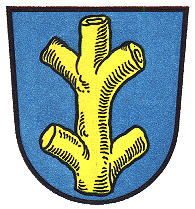Schnaittenbach: Difference between revisions
Knorrepoes (talk | contribs) No edit summary |
Knorrepoes (talk | contribs) m (Text replace - "'''Origin/meaning :'''<br/>" to "====Origin/meaning====") |
||
| Line 14: | Line 14: | ||
[[File:schnait2.jpg|center]] | [[File:schnait2.jpg|center]] | ||
====Origin/meaning==== | |||
The oldest seal of the town dates from the late 15<sup>th</sup> century and already shows the above arms. The arms are canting, the verb 'schnaitten' means to remove smaller branches from a tree. A 'Schnaitte' thus is a piece of tree without or with very small branches. All later seals and images show the same composition. The colours are known since 1812. | The oldest seal of the town dates from the late 15<sup>th</sup> century and already shows the above arms. The arms are canting, the verb 'schnaitten' means to remove smaller branches from a tree. A 'Schnaitte' thus is a piece of tree without or with very small branches. All later seals and images show the same composition. The colours are known since 1812. | ||
Revision as of 08:55, 1 April 2012
| Heraldry of the World Civic heraldry of Germany - Deutsche Wappen (Gemeindewappen/Kreiswappen) |
SCHNAITTENBACH
State : Bayern
District (Kreis) : Amberg-Sulzbach
Additions : 1938 Forst, Unterschnaittenbach; 1946 Demenricht, Holzhammer (1st part); 1972 Haidhof, Holzhammer (2nd part), Neuersdorf; 1978 Kemnath am Buchberg (19?? Döswitz, Götzendorf, Mertenberg, Sitzambuch, Trichenricht)
Origin/meaning
The oldest seal of the town dates from the late 15th century and already shows the above arms. The arms are canting, the verb 'schnaitten' means to remove smaller branches from a tree. A 'Schnaitte' thus is a piece of tree without or with very small branches. All later seals and images show the same composition. The colours are known since 1812.
Literature : Stadler, K. : Deutsche Wappen - Bundesrepublik Deutschland. Angelsachsen Verlag, 1964-1971, 8 volumes.

